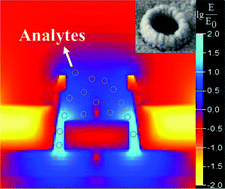Research concerning plasmonic materials has erupted in recent years due to the unique optical and electrical properties afforded by nanoscale structures. The optical properties of plasmonic materials can be tuned by altering the distance between the gaps of metallic nanostructures, which support surface plasmon resonances (SPR), on a patterned array. The gaps between the nanostructures produce significantly high electric field enhancements that enable the sensitive detection of biomolecules or chemicals within the gaps.
In this HOT article, Ai and co-workers have produced unique plasmonic substrates for sensing applications: disk-in-volcano arrays. The arrays were formed using colloidal lithography techniques wherein polystyrene spheres (PS) were first deposited onto a substrate coated with a photoresist film. Next, active ion etching (RIE) was used to etch the film followed by a vertical silver (Ag) deposition. Finally, the PS and photoresist film were removed with toluene and ethanol, followed by another Ag deposition. The final structures consist of a cavity containing a disk with small nanogaps between the disk and the wall of the “volcano”. The proximity of the disk to the wall results in plasmonic coupling and greatly enhanced electric fields.
The advantages of the confined sensing area of the disk-in-volcano arrays are low background, due to the decreased detection area, and low reagent consumption, making these arrays particularly cost effective. These favorable advantages mean disk-in-volcano arrays show potential in applications such as biosensing, optical and electrical trapping and single-molecule analysis.
Dr Lee Barrett is a guest web writer for the Nanoscale blog. Lee is currently a postdoctoral researcher in the Centre for Molecular Nanometrology at the University of Strathclyde. His research is currently focused on the development of nanoparticle-based sensors and surface enhanced Raman scattering (SERS).











